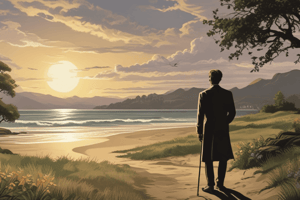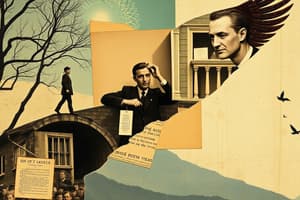Podcast
Questions and Answers
What happens to the falcon in the opening lines of the text?
What happens to the falcon in the opening lines of the text?
What does the phrase 'the blood-dimmed tide' most likely represent?
What does the phrase 'the blood-dimmed tide' most likely represent?
What imagery is used to describe the creature in the desert?
What imagery is used to describe the creature in the desert?
What does the phrase 'the centre cannot hold' imply about the state of the world?
What does the phrase 'the centre cannot hold' imply about the state of the world?
Signup and view all the answers
What does the 'rough beast' symbolize in the context of the text?
What does the 'rough beast' symbolize in the context of the text?
Signup and view all the answers
Study Notes
Major Themes
- Chaos and Anarchy: The imagery of "things fall apart" reflects a breakdown of societal structures, suggesting a world in turmoil.
- Loss of Communication: The falcon's inability to hear the falconer symbolizes a disconnect between control and chaos.
- Moral Ambiguity: The "best lack all conviction" while the "worst are full of passionate intensity," highlighting the disparity between virtuous and malevolent forces in society.
Symbolism
- Falcon and Falconer: Represents the loss of human agency and the failure of leadership.
- Desert and Lion-Man Creature: The grotesque figure suggests an ominous rebirth, indicating a transition into a chaotic new order.
- Spiritus Mundi: Refers to a universal spirit or collective consciousness, evoking shared human experiences and collective fears.
Imagery and Tone
- Blood-Dimmed Tide: Conveys violence and chaos, suggesting widespread conflict or suffering.
- Stony Sleep: Alludes to inaction or ignorance over centuries, indicating a need for awakening.
- Nightmare and Rough Beast: The "rough beast" symbolizes impending change, accompanied by fear and uncertainty.
Historical and Cultural Context
- Second Coming: Rhetorical reference to Christian eschatology, anticipating a transformative event that challenges existing beliefs.
- Critique of Modern Society: Reflects post-World War I disillusionment, grappling with loss of faith in progress and order.
Structure and Form
- Free Verse: Lack of consistent rhythm or rhyme emphasizes the chaotic themes and urgent emotions.
- Closing Question: "What rough beast, its hour come round at last," invites reflection on the nature of change and what may arise from chaos.
Studying That Suits You
Use AI to generate personalized quizzes and flashcards to suit your learning preferences.
Description
Test your understanding of W.B. Yeats' poem 'The Second Coming.' This quiz covers key themes, symbols, and interpretations of the text. Challenge yourself to explore the poem's profound insights into chaos and prophecy.




